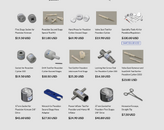Hosted on gue.com of all places:
I love the file name has "Sanitized" in it.
Keep it clean

Thanks for the link!
I read the chapter in that book on regulator O2 cleaning and the gist of it is:
Completely dismantle the parts.
Inspect for any corrosion or "gunk".
Rid of any corrosion in 5% vinegar
Soak in soapy water (citric acid based cleaners suggested)
Scrub with toothbrush, pick threads with toothpick.
Rinse in fresh water bath (Doesn't say how many times but there is a "final rinse")
Water kept for testing
Either dried with airgun, oven (?!) or left out to dry.
Parts should be examined by the "Beads test" which is spraying demineralised water on to the dry part to see if it beads.
Checked by eye in strong light.
Last rinse water bath put in small container and shaken to test for leftover detergent.
Reassembled with O2 safe lube.
My imagined procedure was:
Completely dismantle parts as per manual
Inspect parts carefully of any corrosion
Scrub clean with toothbrush in water.
[only touch with gloves from this point]
Run in BIOX solution in the ultrasonic cleaner.
Run in water in ultrasonic cleaner.
Visually inspect and do beads test.
Air-dry.
Clean all needed tools with soapy water, rinse, airdry, wipe down with IPA.
Clear a working area.
Reassemble regs with new service kit and Christo-lube.





